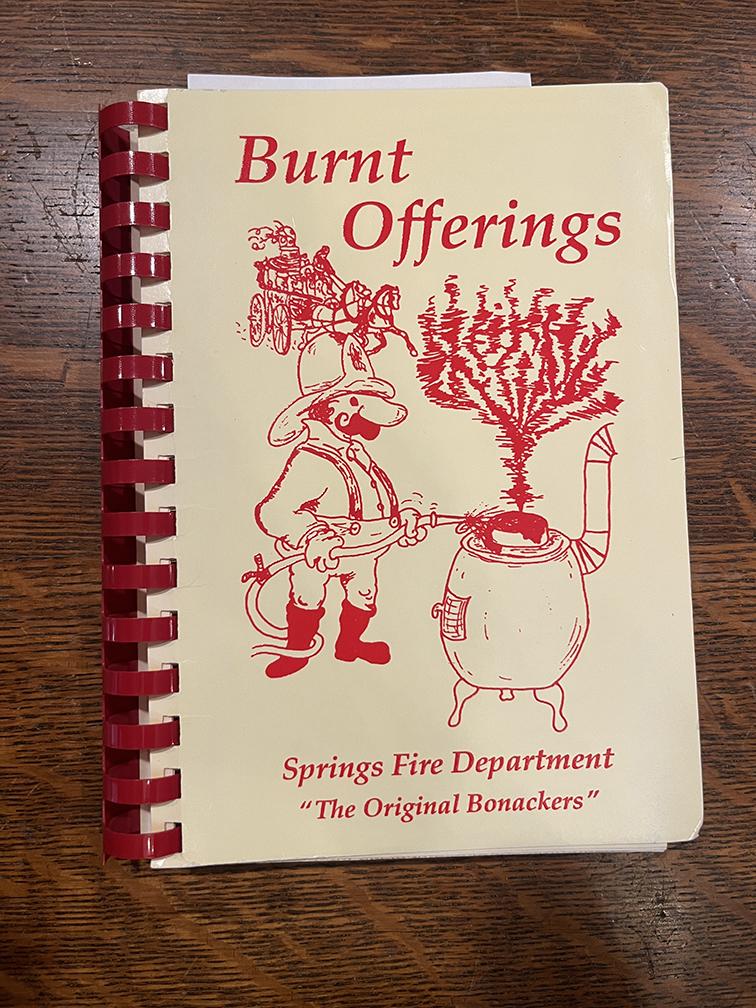The recipes bear their creators' names, which are as familiar as the history of East Hampton itself -- Tyler, Edwards, King, Woodhall, Carll, Lester, and countless others -- dating back decades and decades. The oldest ones are handwritten, as elegant as the founders' yet hard to read by today's standards, and others bear the signature font of a typewriter. And it's all on display for the community to see, under the title "The Way We Cooked in East Hampton: Recipes From the Long Island Collection" at the East Hampton Library, on view in the lobby through the spring of 2025.
Librarians, archivists, and volunteers combed through a collection of more than 100 cookbooks to find the best of the best to share with the community. Many came from private family collections, like those of the Hedges and Gardiner families, while others came from institutions such as the Ladies Village Improvement Society, Springs Fire Department, and Southampton Hospital.
"This turned into looking at culinary history, trends, and social aspects," said Julia Tyson, a librarian and archivist who helped curate the exhibit, and who herself happens to collect vintage cookbooks. "Early recipes didn't have bake times or temperatures. There was just an assumption that people knew. What does that say about the people who are making them?"
Recipes on view include Mrs. U.S. Reininger's bluefish cakes, Mrs. J.A. Tyler's clam soup, Frank Tuma's Montauk Tavern fish chowder, Mrs. Everett J. Edwards's clam pie, Mary Stratton Dayton's deviled clams, and Penny Helm's baked clams. If you've noticed a trend there, you're not the only one.
"There are so many clam and oyster recipes! And chowder. Codfish chowder? I could totally see David [Rattray] making this," remarked Andrea Meyer, the librarian and archivist who heads the Long Island Collection.
There's also a focus on recipes that only an adventurous person would try today. "Tastes have changed," Ms. Meyer said. "Grapefruit and cabbage salad in gelatin? No thanks. And how many different types of pudding do you want to eat in one night?"
There are some intentionally humorous recipes, such as one for "Les Coot de Mason" by someone identified only as "Chef Bub," published in the Springs Fire Department's "Burnt Offerings" cookbook in 1993. There is also an entire volume called "You Can't Be Too Rich or Too Thin: Favorite Recipes From the Hamptons," published in 1988 by an unlikely source -- Southampton Hospital.
One interesting exhibit note describes Helen Miller Stratton's 1896 recipe for stuffed mangoes, which oddly enough doesn't actually include mango as an ingredient: "When mangoes were first imported to the United States, they had to be pickled due to long distances and lack of refrigeration. In some regions of the United States, the term 'mango' was used in place of 'green peppers' in many 19th and early-20th century recipes."
Who knew?
"The Way We Cooked" is also a lesson in intentional feminism.
Ms. Tyson, along with Ms. Meyer, Megan Bardis, another librarian/archivist, Adelaide Webb, a scanning assistant, and Lisa Standiford, a volunteer, noticed that many recipes were created by women who were identified by their husband's names; recipes by Sarah Griswold Gardiner Tyler, for instance, were credited to "Mrs. John Alexander Tyler." They then spent considerable time tracking down their first names. The naming convention was primarily a trend of a bygone era -- try doing that today and you might get told off -- "but on our own, we can certainly do the legwork," Ms. Meyer said. "It was perpetuating a problem, and we didn't want to make it worse."
When the exhibit first debuted in October, the library held a baking contest, asking a panel of expert judges (who shall not be named) to do a blind taste-test and crown a winner. With her take on an old-fashioned chocolate spice cake from the 1939 L.V.I.S. Cookbook, Jennifer Brondo earned first place in the competition.
"The recipe didn't have all the information. It said things like 'just add cinnamon and cloves,' but not how much. And at the end it just said 'bake.' So I kind of used my home-baking instincts," Ms. Brondo said. "It wasn't hard to follow, it just had some holes that I had to guess at. I made a little extra one so that I could cut into it and try it. I thought it was delicious, and my two taste-testers at home loved it, too."
She felt proud of her accomplishment and became more confident in her own baking skills. She also "felt a connection to the past. I felt kind of special, making a recipe that was written by someone who lived here in basically World War II time, hoping I was going to do it justice."
The exhibit is on view during normal operating hours. The library intends to add additional programs to interact with the exhibit, so fans of food -- and history -- should watch its calendar (and the pages of The Star) for more information as it becomes available.
Frank Tuma's Montauk Tavern Fish Chowder
4 to 5 pounds sea bass, cut into two-inch squares
2 qts. water
1 tsp. whole black pepper
2 bay leaves
4 onions, diced
2 green peppers, diced
1 cup celery, diced
2 cups potatoes, diced
1 can tomatoes
1/2 pound salt pork, dried
Boil ingredients until tender, then add salt pork. Add the fish last, after everything else has already been cooked. Boil for four or five minutes and serve.





